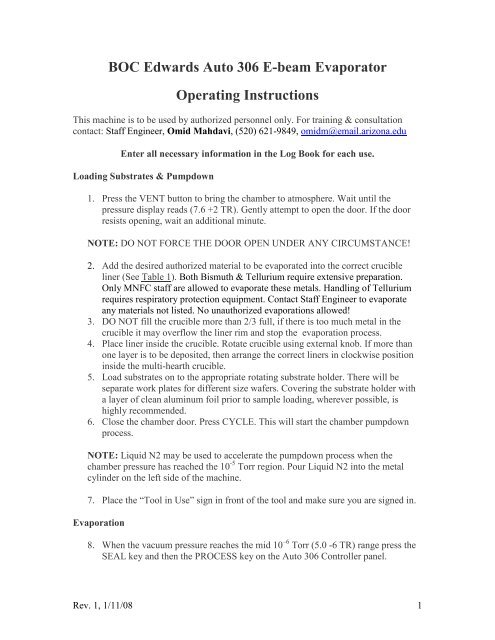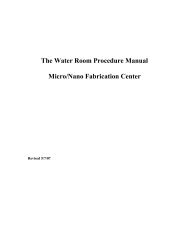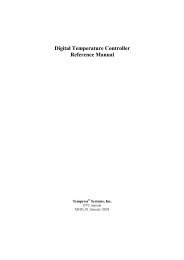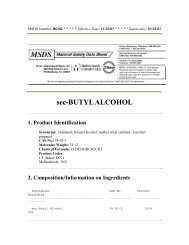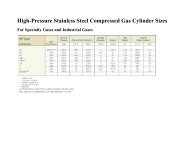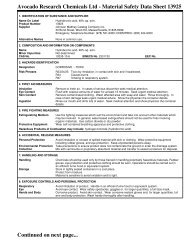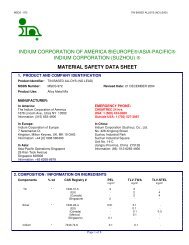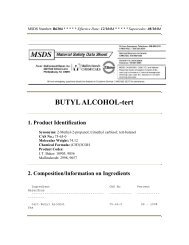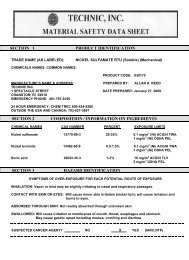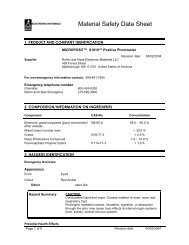BOC Edwards Auto 306 E-beam Evaporator Operating Instructions
BOC Edwards Auto 306 E-beam Evaporator Operating Instructions
BOC Edwards Auto 306 E-beam Evaporator Operating Instructions
Create successful ePaper yourself
Turn your PDF publications into a flip-book with our unique Google optimized e-Paper software.
<strong>BOC</strong> <strong>Edwards</strong> <strong>Auto</strong> <strong>306</strong> E-<strong>beam</strong> <strong>Evaporator</strong><br />
<strong>Operating</strong> <strong>Instructions</strong><br />
This machine is to be used by authorized personnel only. For training & consultation<br />
contact: Staff Engineer, Omid Mahdavi, (520) 621-9849, omidm@email.arizona.edu<br />
Enter all necessary information in the Log Book for each use.<br />
Loading Substrates & Pumpdown<br />
1. Press the VENT button to bring the chamber to atmosphere. Wait until the<br />
pressure display reads (7.6 +2 TR). Gently attempt to open the door. If the door<br />
resists opening, wait an additional minute.<br />
NOTE: DO NOT FORCE THE DOOR OPEN UNDER ANY CIRCUMSTANCE!<br />
2. Add the desired authorized material to be evaporated into the correct crucible<br />
liner (See Table 1). Both Bismuth & Tellurium require extensive preparation.<br />
Only MNFC staff are allowed to evaporate these metals. Handling of Tellurium<br />
requires respiratory protection equipment. Contact Staff Engineer to evaporate<br />
any materials not listed. No unauthorized evaporations allowed!<br />
3. DO NOT fill the crucible more than 2/3 full, if there is too much metal in the<br />
crucible it may overflow the liner rim and stop the evaporation process.<br />
4. Place liner inside the crucible. Rotate crucible using external knob. If more than<br />
one layer is to be deposited, then arrange the correct liners in clockwise position<br />
inside the multi-hearth crucible.<br />
5. Load substrates on to the appropriate rotating substrate holder. There will be<br />
separate work plates for different size wafers. Covering the substrate holder with<br />
a layer of clean aluminum foil prior to sample loading, wherever possible, is<br />
highly recommended.<br />
6. Close the chamber door. Press CYCLE. This will start the chamber pumpdown<br />
process.<br />
NOTE: Liquid N2 may be used to accelerate the pumpdown process when the<br />
chamber pressure has reached the 10 -5 Torr region. Pour Liquid N2 into the metal<br />
cylinder on the left side of the machine.<br />
7. Place the “Tool in Use” sign in front of the tool and make sure you are signed in.<br />
Evaporation<br />
8. When the vacuum pressure reaches the mid 10 –6 Torr (5.0 -6 TR) range press the<br />
SEAL key and then the PROCESS key on the <strong>Auto</strong> <strong>306</strong> Controller panel.<br />
Rev. 1, 1/11/08 1
9. Using the FTM7 Film Thickness Monitor select the appropriate layer for the<br />
metal you wish to deposit (see Table 1). To set the desired thickness press the<br />
DATA button until the TERMINATE light is illuminated. Press the UP or<br />
DOWN arrow keys to set to the desired thickness. Continue pressing the DATA<br />
button until the RATE light is illuminated.<br />
10. On the EB3 Source Control panel ensure that the current knob is set to the<br />
minimum. Press in the HIGH VOLTAGE button after the vacuum interlock light<br />
is illuminated. Press in the GUN button and make sure the light comes on.<br />
11. Verify that the REMOTE and the SS1 buttons are pressed in on the shutter control<br />
panel.<br />
12. On the EB3 Source Control panel, increase the current slowly by rotating the<br />
current knob clockwise to 15 mA if practical based on Table 1 data. Let the metal<br />
and crucible stay (soak) at this setting for a few minutes. The metal inside the<br />
liner should start glowing.<br />
NOTE: Both Bismuth (Bi) & Tellurium (Te) will start evaporating well below 10mA<br />
13. Increase the current in increments of 5 mA and soak periods of 2-3 minutes until a<br />
desired deposition rate appears on the FTM7 monitor. Use Table 2 as a guide.<br />
14. Turn on the Sweep Control & use the X-Axis control knob located on the separate<br />
control box on the top to ensure the <strong>beam</strong> is centered inside the liner. You can<br />
sweep or oscillate the <strong>beam</strong> inside the liner for a more uniform melt.<br />
15. Press the RUN button on the FTM7 panel to open the shutter and begin counting<br />
the film thickness on the samples.<br />
16. The shutter will close automatically when the desired thickness is reached.<br />
17. Slowly i.e. no faster than 10 mA in 30 seconds, reduce the current back to zero.<br />
Allow the crucible to cool until it is no longer giving off a glow.<br />
18. Using the turn knob change to a different liner position clockwise and repeat ramp<br />
and soak process starting at step 12.<br />
19. If you are done with evaporation, then depress the GUN and HIGH VOLTAGE<br />
buttons to turn them OFF.<br />
20. On the Main Controller panel press the SEAL button to protect the turbo pump.<br />
21. Press the VENT button to bring the chamber to atmosphere. Wait until the<br />
pressure display reads (7.6 +2 TR). Gently attempt to open the door. If the door<br />
resists opening, wait a few additional minutesNever force the chamber door open.<br />
Give the chamber a few minutes to vent and the door will not offer resistance.<br />
22. Contact a MNFC staff member for a designated vacuum cleaner, if you observe<br />
metal flakes and other debris.<br />
23. Once your samples have been removed, close the door and press the CYCLE<br />
button to leave the system under vacuum for the next user.<br />
CAUTION: Contact a Staff Member Immediately if you observe anything unusual, e.g.<br />
no power to the tool!<br />
Rev. 1, 1/11/08 2
Table 1 – Allowable Evaporation Material & Relevant Properties<br />
Metal Liner Material Layer Density<br />
(g.cm -3 z-value<br />
)<br />
Aluminum (Al) (Contact Staff Engineer) 1 2.70 8.17<br />
Titanium (Ti) Intermetallic 2 4.50 14.05<br />
Copper (Cu) Graphite 3 8.93 20.20<br />
Chromium (Cr) Graphite 4 7.20 28.94<br />
Gold (Au) Graphite 5 19.3 23.17<br />
Platinum (Pt) Graphite 6 21.4 36.06<br />
Bismuth (Bi) ** Graphite 7 9.80 8.1<br />
Tellurium (Te) ** Intermetallic 9 6.25 9.3<br />
Silver (Ag) Graphite 10 10.5 16.68<br />
Germanium (Ge) Intermetallic 11 5.35 17.1<br />
** - Both Bismuth & Tellurium require extensive preparation. Only MNFC staff are<br />
allowed to evaporate these metals. Handling of Tellurium requires respiratory protection<br />
equipment. You must contact the Staff Engineer to deposit any material not listed.<br />
Table 2 – Typical Evaporation Behavior in the MNFC <strong>Auto</strong> <strong>306</strong> E-<strong>beam</strong><br />
Evaporation System.<br />
Metal Pole Piece Width Voltage Current Deposition Rate<br />
(mm) (kV) (mA) (nm/sec)<br />
Titanium (Ti) 8 4.5 72 0.04<br />
Copper (Cu) 8 4.5 50 0.4<br />
Chromium (Cr) 8 4.5 47 0.08<br />
Germanium (Ge) 8 4.9 160 0.04<br />
Gold (Au) 8 4.5 75 0.1<br />
Gold (Au) 9.5 4.5 82 0.04<br />
Platinum (Pt) 9.5 4.5 290 0.05<br />
Bismuth (Bi) 10.5 4.5 9 0.2<br />
Tantalum (Ta)** 8 & 9.5 4.45 500 No Deposition<br />
Tellurium (Te) 9.5 4.45 2 0.2<br />
Data compiled by Omid Mahdavi from runs between 1/07 & 1/08<br />
** We were unable to process this metal on our tool. Do not attempt to evaporate!<br />
Rev. 1, 1/11/08 3
Deposition Rate (nm/s)<br />
Figure 1 - Evaporation Behavior of Titanium at 4.5kV (8mm pole piece)<br />
0.08<br />
0.07<br />
0.06<br />
0.05<br />
0.04<br />
0.03<br />
0.02<br />
0.01<br />
0<br />
Data by Sean Essex<br />
-0.01<br />
0 10 20 30 40 50 60 70 80 90 100<br />
Beam Current (mA)<br />
Process Consumables<br />
• Liners (Graphite, Intermetallic): 4cc, Super Conductor Materials Inc.<br />
• Copper: Kurt J. Lesker, Pellets 1/8”x1/8”, 99.99%, EVMCU40EXEB or CERAC<br />
Inc., 3mmx3mm pellets, 99.99%, C-2073<br />
• Gold: Kurt J. Lesker,


